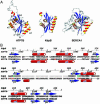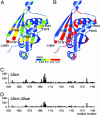Solution structure of the N-domain of Wilson disease protein: distinct nucleotide-binding environment and effects of disease mutations
- PMID: 16567646
- PMCID: PMC1459350
- DOI: 10.1073/pnas.0507416103
Solution structure of the N-domain of Wilson disease protein: distinct nucleotide-binding environment and effects of disease mutations
Abstract
Wilson disease protein (ATP7B) is a copper-transporting P(1B)-type ATPase that regulates copper homeostasis and biosynthesis of copper-containing enzymes in human tissues. Inactivation of ATP7B or related ATP7A leads to severe neurodegenerative disorders, whereas their overexpression contributes to cancer cell resistance to chemotherapeutics. Copper-transporting ATPases differ from other P-type ATPases in their topology and the sequence of their nucleotide-binding domain (N-domain). To gain insight into the structural basis of ATP7B function, we have solved the structure of the ATP7B N-domain in the presence of ATP by using heteronuclear multidimensional NMR spectroscopy. The N-domain consists of a six-stranded beta-sheet with two adjacent alpha-helical hairpins and, unexpectedly, shows higher similarity to the bacterial K(+)-transporting ATPase KdpB than to the mammalian Ca(2+)-ATPase or Na(+),K(+)-ATPase. The common core structure of P-type ATPases is retained in the 3D fold of the N-domain; however, the nucleotide coordination environment of ATP7B within this fold is different. The residues H1069, G1099, G1101, I1102, G1149, and N1150 conserved in the P(1B)-ATPase subfamily contribute to ATP binding. Analysis of the frequent disease mutation H1069Q demonstrates that this mutation does not significantly affect the structure of the N-domain but prevents tight binding of ATP. The structure of the N-domain accounts for the disruptive effects of >30 known Wilson disease mutations. The unique features of the N-domain provide a structural basis for the development of specific inhibitors and regulators of ATP7B.
Conflict of interest statement
Conflict of interest statement: No conflicts declared.
Figures






References
-
- Puig S., Thiele D. J. Curr. Opin. Chem. Biol. 2002;6:171–180. - PubMed
-
- Daniel K. G., Harbach R. H., Guida W. C., Dou Q. P. Front. Biosci. 2004;9:2652–2662. - PubMed
-
- Ferenci P. Aliment. Pharmacol. Ther. 2004;19:157–165. - PubMed
-
- Gitlin J. D. Gastroenterology. 2003;125:1868–1877. - PubMed
-
- Shim H., Harris Z. L. J. Nutr. 2003;133:1527S–1531S. - PubMed
Publication types
MeSH terms
Substances
Associated data
- Actions
Grants and funding
LinkOut - more resources
Full Text Sources
Other Literature Sources
Molecular Biology Databases
Miscellaneous

